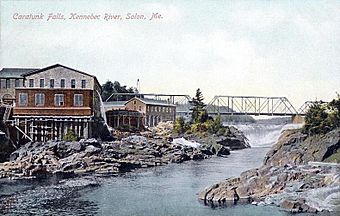Caratunk Falls Archeological District facts for kids
Quick facts for kids |
|
|
Caratunk Falls Archeological District
|
|

Early 20th century postcard view of the industrial use of Caratunk Falls
|
|
| Lua error in Module:Location_map at line 420: attempt to index field 'wikibase' (a nil value). | |
| Nearest city | Solon, Maine |
|---|---|
| Area | 16 acres (6.5 ha) |
| Built | 1776 |
| NRHP reference No. | 86001200 |
| Added to NRHP | May 30, 1986 |
The Caratunk Falls Archeological District is a special place in Solon, Maine. It's like a giant outdoor museum filled with clues about people who lived there long ago. These clues include ancient tools and other items.
Experts first found this important site in the 1960s. State archaeologists then carefully mapped it in the early 1980s. At that time, it was the biggest site of its kind in inland Maine. It showed signs of human life from the ancient Archaic period all the way to when Europeans first arrived. This 16-acre (6.5 ha) area was officially added to the National Register of Historic Places in 1986.
Contents
Discovering Ancient History at Caratunk Falls
This special district is located near Solon, right along the Kennebec River. It's close to where Caratunk Falls used to be. Today, a dam stands there, creating the Kennebec River Reservoir.
The ground here holds many archaeological treasures. These layers of soil are not very thick, but they contain important artifacts. In the 1980s, experts thought the site covered about 16 acres (6.5 ha). However, its full size might be even larger.
How Archaeologists Found the Site
An amateur archaeologist first started collecting items from this area in the 1960s. Later, in the mid-1980s, the state of Maine funded a big study. They dug many small test pits to see what they could find.
More than twenty of these test pits uncovered significant materials. This was a huge discovery for inland Maine. It showed how important the Caratunk Falls area was for understanding the past.
Clues from the Past: What Was Found?
Archaeologists found many interesting things at the site. They discovered a lot of stone toolmaking debris. This material, called debitage, tells us about how people made tools from stone. These tools date from the Middle Archaic period up to the time of European contact.
They also found pieces of pottery. Most of this pottery was different from what was found near the coast. It had unique patterns made with "S-twist" cords.
Early European Connections
The site also held early European trade goods. These items date back to the 17th and 18th centuries. They show that local people traded with Europeans a long time ago.
One very special find is a large boulder with letters carved into it. It says "B. A." and "1776". The way the rock has worn down suggests these carvings are very old and real.
A Link to the American Revolution
It is known that a group of soldiers from the Continental Army passed through this area. This group was led by Benedict Arnold. They were on an important journey in 1775 to attack Quebec City during the American Revolutionary War.
It's possible that the carvings on the boulder are a sign left by Benedict Arnold himself or someone in his group. This makes the Caratunk Falls Archeological District even more fascinating!

